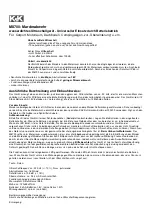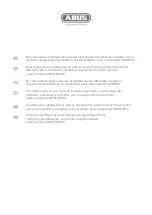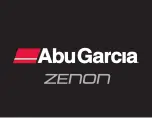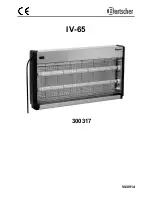
PHOENIX CONTACT GmbH & Co. KG
Flachsmarktstraße 8, 32825 Blomberg, Germany
Fax +49-(0)5235-341200, Phone +49-(0)5235-300
phoenixcontact.com
DE
Einbauanweisung für den Elektroinstallateur
EN
Installation notes for electricians
FR
Instructions d'installation pour l'électricien
2013-12-04
© PHOENIX CONTACT 2013
3-Wege-Trennverstärker
1. Sicherheitshinweise
1.1
Errichtungshinweise
•
Das Gerät der Kategorie 3 ist zur Installation im explosionsgefährdeten Bereich der Zone 2 geeignet. Es
erfüllt die Anforderungen der EN 60079-0:2009 und EN 60079-15:2010.
•
Die Installation, Bedienung und Wartung ist von elektrotechnisch qualifiziertem Fachpersonal
durchzuführen. Befolgen Sie die beschriebenen Installationsanweisungen. Halten Sie die für das Errichten
und Betreiben geltenden Bestimmungen und Sicherheitsvorschriften (auch nationale
Sicherheitsvorschriften), sowie die allgemein anerkannten Regeln der Technik ein. Die
sicherheitstechnischen Daten sind dieser Packungsbeilage und den Zertifikaten (Konformitätsbewertung,
ggf. weitere Approbationen) zu entnehmen.
•
Im Betrieb der Geräte können berührgefährliche Spannungen an den Bedienelementen anliegen. Eine
Parametrierung, das Anschließen von Leitungen oder das Öffnen des Moduldeckels ist deshalb nur im
spannungslosen Zustand erlaubt, sofern es sich bei den angeschlossenen Stromkreisen nicht
ausschließlich um SELV- oder PELV-Stromkreise handelt.
•
Öffnen oder Verändern des Gerätes ist nicht zulässig. Reparieren Sie das Gerät nicht selbst, sondern
ersetzen Sie es durch ein gleichwertiges Gerät. Reparaturen dürfen nur vom Hersteller vorgenommen
werden. Der Hersteller haftet nicht für Schäden aus Zuwiderhandlung.
•
Die Schutzart IP20 (IEC 60529/EN 60529) des Gerätes ist für eine saubere und trockene Umgebung
vorgesehen. Setzen Sie das Gerät keiner mechanischen und/oder thermischen Beanspruchung aus, die die
beschriebenen Grenzen überschreitet.
•
Das Gerät ist nicht für den Einsatz in staubexplosionsgefährdeten Atmosphären ausgelegt.
•
Das Gerät erfüllt die Funkschutzbestimmungen (EMV) für den industriellen Bereich (Funkschutzklasse
A).
Beim Einsatz im Wohnbereich kann es Funkstörungen verursachen.
•
Wenn das Gerät nicht entsprechend der Dokumentation benutzt wird, kann der vorgesehene Schutz
beeinträchtigt sein.
•
Bauen Sie das Gerät zum Schutz gegen mechanische oder elektrische Beschädigungen in ein
entsprechendes Gehäuse mit einer geeigneten Schutzart nach IEC 60529 ein.
•
Sehen Sie in der Nähe des Gerätes einen Schalter/Leistungsschalter vor, der als Trennvorrichtung für dieses
Gerät gekennzeichnet ist.
•
Sehen Sie eine Überstromschutzeinrichtung (I
≤
4 A) in der Installation vor.
•
Das Gerät besitzt durch sein Gehäuse eine Basisisolierung zu benachbarten Geräten für 300
V
eff
. Beachten
Sie dieses bei der Installation mehrerer Geräte nebeneinander und installieren Sie ggf. eine zusätzliche
Isolation. Wenn das benachbarte Gerät eine Basisisolierung besitzt, ist keine zusätzliche Isolierung
notwendig.
•
Die an Eingang, Ausgang und Versorgung anliegenden Spannungen sind Extra-Low-Voltage (ELV)-
Spannungen. Es kann je nach Anwendung vorkommen, dass eine gefährliche Spannung (>
30
V) gegen
Erde anliegt. Für diesen Fall ist eine sichere galvanische Trennung zu den anderen Anschlüssen vorhanden.
•
Das Gerät ist außer Betrieb zu nehmen, wenn es beschädigt ist, unsachgemäß belastet oder gelagert wurde
bzw. Fehlfunktionen aufweist.
1.2
Installation in der Zone 2
•
Halten Sie die festgelegten Bedingungen für den Einsatz in explosionsgefährdeten Bereichen ein! Setzen
Sie bei der Installation ein geeignetes, zugelassenes Gehäuse der Mindestschutzart IP54 ein, das die
Anforderungen der EN
60079-15 erfüllt. Beachten Sie auch die Anforderungen der EN
60079-14.
•
An Stromkreise in der Zone 2 dürfen nur Geräte angeschlossen werden, welche für den Betrieb in der Ex-
Zone 2 und die am Einsatzort vorliegenden Bedingungen geeignet sind.
•
Das Auf- und Abrasten auf den Tragschienen-Busverbinder bzw. das Anschließen und das Trennen von
Leitungen im explosionsgefährdeten Bereich ist nur im spannungslosen Zustand zulässig.
•
Das Gerät ist außer Betrieb zu nehmen und unverzüglich aus dem Ex-Bereich zu entfernen, wenn es
beschädigt ist, unsachgemäß belastet oder gelagert wurde bzw. Fehlfunktionen aufweist.
2. Kurzbeschreibung
Normsignal-3-Wege-Trennverstärker mit steckbarer Anschlusstechnik zur galvanischen Trennung,
Umsetzung, Verstärkung und Filterung von Normsignalen.
3. Bedien- und Anzeigeelemente (
)
1
LED grün "PWR" Spannungsversorgung
2
Abdeckung mit Beschriftungsmöglichkeit
3
Eingang: Normsignale
4
Versorgungsspannung
5
NFC-Spule
6
Universal-Rastfuß für EN-Tragschienen
7
Anschluss für Tragschienen-Busverbinder
8
Befestigungsschraube
9
Ausgang: Normsignale
10
Strommessbuchse
4. Installation
Die Belegung der Anschlussklemmen zeigt das Blockschaltbild. (
)
Das Gerät ist auf alle 35-mm-Tragschienen nach EN
60715 aufrastbar. Bei Einsatz des Tragschienen-
Busverbinders ME
6,2
TBUS-2 (Art.-Nr.: 2869728) legen Sie diesen zur Brückung der Spannungsversorgung
zuerst in die Tragschiene ein. (
)
Aktuelle Dokumente können Sie unter der Adresse phoenixcontact.com herunterladen.
Dieses Gerät bietet die Möglichkeit der NFC-Kommunikation.
Mithilfe der MINI Analog Pro Smartphone App können Sie über die NFC-Schnittstelle Ihres Smartphones
umfangreiche Modulinformationen abrufen.
Die MINI Analog Pro Smartphone App steht Ihnen kostenlos zur Verfügung. (
)
ACHTUNG: Elektrostatische Entladung
Treffen Sie Schutzmaßnahmen gegen elektrostatische Entladung!
ACHTUNG
Beachten Sie unbedingt die Aufrastrichtung von MINI-Analog-Modul und Tragschienen-
Busverbinder: Rastfuß (D) unten und Steckerteil (C) links!
Amplificateur-séparateur 3
voies
1. Consignes de sécurité
1.1
Instructions d'installation
•
Cet appareil de catégorie 3 est conçu pour être installé dans des atmosphères explosibles de zone
2. Il
répond aux exigences des normes EN 60079-0:2009 et EN 60079-15:2010.
•
L’installation, l’utilisation et la maintenance doivent être confiées à un personnel spécialisé dûment qualifié
en électrotechnique. Respecter les instructions d'installation. Lors de l’exécution et de l’exploitation,
respecter les dispositions et normes de sécurité en vigueur (ainsi que les normes de sécurité nationales) de
même que les règles généralement reconnues relatives à la technique. Les caractéristiques relatives à la
sécurité se trouvent dans ces instructions et les certificats joints (attestation de conformité, autres
homologations éventuelles).
•
Des tensions dangereuses peuvent être présentes sur les éléments de commande pendant le
fonctionnement des appareils. Le paramétrage, le raccordement de câbles ou l'ouverture du couvercle de
module ne sont donc autorisés qu'avec une installation hors tension, dans la mesure où il ne s'agit
uniquement de circuits électriques de type SELV- ou PELV-.
•
L'ouverture ou la transformation de l'appareil ne sont pas admissibles. Ne procédez à aucune réparation sur
l'appareil, mais remplacez-le par un appareil équivalent. Seul le fabricant est autorisé à effectuer des
réparations sur l’appareil. Le fabricant n’est pas responsable des dommages résultant d’infractions à cette
règle.
•
L’indice de protection IP20 (CEI
60529/EN
60529) de l’appareil est valable dans un environnement propre et
sec. Ne pas soumettre l’appareil à des sollicitations mécaniques et/ou thermiques dépassant les limites
décrites.
•
L’appareil n’est pas conçu pour être utilisé dans des atmosphères dangereuses (poussière).
•
L'appareil est conforme répond aux règlements relatifs aux parasites (CEM) destinés au domaine industriel
(catégorie de protection
A). L'utilisation dans une zone d'habitation peut créer des parasites.
•
Si l'appareil n'est pas utilisé conformément à la documentation, ceci peut entraver la protection prévue.
•
Prévoir si nécessaire le montage dans un boîtier à indice de protection adéquat selon CEI 60529 pour
protéger l'appareil contre les dommages mécaniques ou électriques.
•
Prévoir, à proximité de l'appareil, un commutateur/disjoncteur caractérisé comme étant le dispositif de
déconnexion de cet appareil.
•
Prévoir un dispositif de protection contre les surintensités (I
≤
4 A) dans l'installation.
•
Le boîtier de l'appareil lui confère une isolation de base vis-à-vis des appareils voisins pour 300
Veff. Il
convient d'en tenir compte lors de l'installation de plusieurs appareils côte à côte et d'installer une isolation
supplémentaire si cela est nécessaire. Si l'appareil voisin présente lui aussi une isolation de base, aucune
isolation supplémentaire n'est requise.
•
Les tensions appliquées à l'entrée, à la sortie et à l'alimentation sont des très basses tensions. Selon
l'application, il peut arriver qu'une tension dangereuse (>
30
V) existe contre la terre. Dans ce cas, une
isolation galvanique sûre avec les autres raccordements existe.
•
L'appareil doit être mis hors service s'il est endommagé, soumis à une contrainte ou stocké de manière
incorrecte, ou bien s'il présente des dysfonctionnements.
1.2
Installation en zone
2
•
Respecter les conditions définies pour l'utilisation en atmosphère explosible. Lors de l’installation, utiliser un
boîtier adapté et homologué (indice minimum de protection IP54) qui répond aux exigences de la norme EN
60079-15. Respecter également les exigences de la norme EN
60079-14.
•
Seuls les appareils destinés à être utilisés dans la zone Ex 2 et conçus pour être utilisés conformément aux
conditions présentes du lieu d'utilisation peuvent être raccordés à des circuits de la zone 2.
•
L’encliquetage, le désencliquetage sur le connecteur sur profilé et la connexion et la déconnexion de câbles
en atmosphère explosible sont uniquement autorisés hors tension.
•
L’appareil doit être mis hors service et retiré immédiatement de la zone Ex s’il est endommagé ou s’il a été
soumis à des charges ou stocké de façon non conforme, ou s’il présente un dysfonctionnement.
2. Brève description
Amplificateur-séparateur à 3 voies et connectique enfichable pour l'isolation galvanique, la conversion,
l'amplification et le filtrage de signaux normalisés standard.
3. Eléments de commande et voyants (
)
1
LED verte «
PWR
», alimentation en tension
2
Capot avec possibilité de repérage
3
Entrée : signaux normalisés
4
Tension d'alimentation
5
Bobine NFC
6
Pied encliquetable universel pour profilés EN
7
Raccordement pour connecteur sur profilé
8
Vis de fixation
9
Sortie : signaux normalisés
10
Douille de mesure de courant
4. Installation
L'affectation des bornes de raccordement est illustrée dans le schéma de connexion. (
)
L'appareil est encliquetable sur tous les profilés 35
mm conformes à EN
60715. En cas d'utilisation du
connecteur sur profilé ME
6,2
TBUS-2 (réf.
: 2869728), placer d'abord le connecteur sur le profilé pour ponter
l'alimentation en tension. (
)
Les documents actuels peuvent être téléchargés à l'adresse phoenixcontact.com.
Cet appareil permet la communication NFC.
À l'aide de l'application pour Smartphone MINI Analog Pro vous pouvez accéder à de nombreuses
informations de module via l'interface NFC de votre Smartphone.
L'application MINI Analog Pro pour Smartphone est disponible gratuitement. (
)
IMPORTANT
: décharge électrostatique
Prendre les mesures de protection appropriées contre les décharges électrostatiques.
IMPORTANT
Respecter impérativement le sens d'encliquetage du module MINI Analog et du connecteur sur
profilé
: pied encliquetable (D) en bas, élément enfichable (C) à gauche!
3-way isolating amplifier
1. Safety notes
1.1
Installation notes
•
The category 3 device is suitable for installation in potentially explosive area zone 2. It fulfills the requirements
of EN 60079-0:2009 and EN 60079-15:2010.
•
Installation, operation, and maintenance may only be carried out by qualified electricians. Follow the
installation instructions as described. When installing and operating the device, the applicable regulations
and safety directives (including national safety directives), as well as generally approved technical
regulations, must be observed. The safety data is provided in this package slip and on the certificates
(conformity assessment, additional approvals where applicable).
•
While the devices are in operation, contact-dangerous voltages may be present on the control elements. For
this reason parameterization, conductor connection, and opening of the module lid are allowed only when
devices are in a de-energized state unless the connected circuits are exclusively SELV or PELV circuits.
•
The device must not be opened or modified. Do not repair the device yourself, replace it with an equivalent
device. Repairs may only be carried out by the manufacturer. The manufacturer is not liable for damage
resulting from violation.
•
The IP20 protection (IEC 60529/EN 60529) of the device is intended for use in a clean and dry environment.
The device must not be subject to mechanical strain and/or thermal loads, which exceed the limits described.
•
The device is not designed for use in atmospheres with a danger of dust explosions.
•
The device complies with the EMC regulations for industrial areas (EMC class
A). When using the device in
residential areas, it may cause radio interference.
•
If the device is not used as described in the documentation, the intended protection can be negatively
affected.
•
To protect the device against mechanical or electrical damage, install it in a suitable housing with appropriate
degree of protection according to IEC 60529.
•
Provide a switch/circuit breaker close to the device, which is labeled as the disconnecting device for this
device.
•
Provide for a overcurrent protection device (I
≤
4 A) in the installation.
•
Thanks to its housing, the device has basic insulation to the neighboring devices, for 300 Veff. If several
devices are installed next to each other, this has to be taken into account, and additional insulation has to be
installed if necessary! If the neighboring device is equipped with basic insulation, no additional insulation is
necessary.
•
The voltages present at the input, output and supply are extra-low voltages (ELV). Depending on the
application, dangerous voltage (>
30
V) against ground could occur. For this event, safe electrical isolation
from the other connections has been implemented.
•
The device must be stopped if it is damaged, has been subjected to an impermissible load, stored incorrectly,
or if it malfunctions.
1.2
Installation in Zone 2
•
Observe the specified conditions for use in potentially explosive areas! Install the device in a suitable
approved housing with a minimum of IP54 protection) that meets the requirements of EN 60079-15. Observe
the requirements of EN 60079-14.
•
Only devices which are designed for operation in Ex zone 2 and are suitable for the conditions at the
installation location may be connected to the circuits in the Ex zone.
•
In potentially explosive areas, terminals may only be snapped onto or off the DIN rail connector and wires
may only be connected or disconnected when the power is switched off.
•
The device must be stopped and immediately removed from the Ex area if it is damaged, was subject to an
impermissible load, stored incorrectly or if it malfunctions.
2. Short description
The standard signal 3-way signal conditioner with pluggable connection technology is used to electrically
isolate, condition, amplify, and filter standard signals.
3. Operating and indicating elements (
)
1
Green “PWR” LED, power supply
2
Cover with labeling option
3
Input: Standard signals
4
Supply voltage
5
NFC coil
6
Universal snap-on foot for EN DIN rails
7
Connection for DIN rail connector
8
Mounting screw
9
Output: Standard signals
10
Current measuring socket
4. Installation
The assignment of the connection terminal blocks is shown in the block diagram. (
)
The device can be snapped onto all 35 mm DIN rails according to EN
60715. When using the ME
6,2
TBUS-2
DIN rail connector (Order No. 2869728), first position it in the DIN rail to bridge the voltage supply. (
)
You can download the latest documents from phoenixcontact.com.
This device offers the option of NFC communication.
You can use the MINI Analog Pro Smartphone app to call-up comprehensive module information via the
NFC interface of your Smartphone.
The MINI Analog Pro Smartphone app is available to you free. (
)
NOTE: Electrostatic discharge
Take protective measures against electrostatic discharge.
NOTE
It is essential to observe the snap-in direction of the MINI analog module and DIN rail
connector: Snap-on foot (D) below and plug component (C) left!
DEUTSCH
ENGLISH
FRANÇAIS
MNR 9063881
PNR 105710 - 01
DNR 83147798 - 01
MINI MCR-2-I4-U
2902002
MINI MCR-2-I4-U-PT
2902003
1
5
3
6
7
8
4
9
2
10
4
Zone 2
IN
Sensor / Field
OUT
PLC / DCS
4-wire
OUT
I+
U
S
5
6
1
2
PWR+
PWR–
+
+
+
–
–
–
–
+
FM
1
5
2
6
3
7
4
8
IN I+
OUT U+
TI–
PWR+
PWR–
IN I–
PWR+
PWR–
OUT U–
OUT
I-
A
D
C
B
E
MINI MCR-2-…
AWG 26-16
0,2-1,5 mm
2
10 mm
A
B
0,5-0,6 Nm
5-7 lb ln
B
A
MINI MCR-2-…-PT
A
AWG 26-12
0,2-2,5 mm
2
10 mm
























